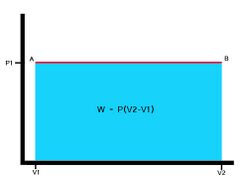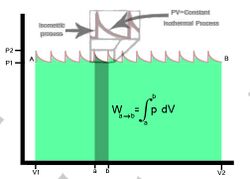Physics:Thermodynamic process path
A thermodynamic process path is the path or series of states through which a system passes from an initial equilibrium state to a final equilibrium state[1] and can be viewed graphically on a pressure-volume (P-V), pressure-temperature (P-T), and temperature-entropy (T-s) diagrams.[2]
There are an infinite number of possible paths from an initial point to an end point in a process. In many cases the path matters, however, changes in the thermodynamic properties depend only on the initial and final states and not upon the path.[3]
Consider a gas in cylinder with a free floating piston resting on top of a volume of gas V1 at a temperature T1. If the gas is heated so that the temperature of the gas goes up to T2 while the piston is allowed to rise to V2 as in Figure 1, then the pressure is kept the same in this process due to the free floating piston being allowed to rise making the process an isobaric process or constant pressure process. This Process Path is a straight horizontal line from state one to state two on a P-V diagram.
It is often valuable to calculate the work done in a process. The work done in a process is the area beneath the process path on a P-V diagram. Figure 2 If the process is isobaric, then the work done on the piston is easily calculated. For example, if the gas expands slowly against the piston, the work done by the gas to raise the piston is the force F times the distance d. But the force is just the pressure P of the gas times the area A of the piston, F=PA.[4] Thus
- W=Fd
- W=PAd
- W=P(V2-V1)
Now let’s say that the piston was not able to move smoothly within the cylinder due to static friction with the walls of the cylinder. Assuming that the temperature was increased slowly, you would find that the process path is not straight and no longer isobaric, but would instead undergo an isometric process till the force exceeded that of the frictional force and then would undergo an isothermal process back to an equilibrium state. This process would be repeated till the end state is reached. See figure 3. The work done on the piston in this case would be different due to the additional work required for the resistance of the friction. The work done due to friction would be the difference between the work done on these two process paths.
Many engineers neglect friction at first in order to generate a simplified model.[5] For more accurate information, the height of the highest point, or the max pressure, to surpass the static friction would be proportional to the frictional coefficient and the slope going back down to the normal pressure would be the same as an isothermal process if the temperature was increased at a slow enough rate.[6]
Another path in this process is an isometric process. This is a process where volume is held constant which shows as a vertical line on a P-V diagram. Figure 3 Since the piston is not moving during this process, there is not any work being done.[7]
References
- ↑ Thermodynamics (Third Edition), Kenneth Wark, McGraw-Hill Inc, 1977, ISBN:0-07-068280-1
- ↑ Fundamentals of Engineering Thermodynamics (Seventh Edition), Michael J. Moran, Howard N. Shapiro, Daisie D. Boettner, Margaret B. Bailey, John Wiley & Sons, Inc., 2011, ISBN:978-0470-49590-2
- ↑ Philip E. Bloomfield, William A. Steele, "Thermodynamic processes," in AccessScience, ©McGraw-Hill Companies, 2008, http://www.accessscience.com
- ↑ Physics – Principles with Applications (Second Edition), Douglas C, Giancoli, Printice Hall, Inc., 1985, ISBN:0-13-672627-5
- ↑ Thermodynamics – Fundamentals for Applications, John P. O’Connell, J.M. Haile, Cambridge University Press, 2005, ISBN:978-0-521-58206-3
- ↑ Physics – Principles with Applications (Second Edition), Douglas C, Giancoli, Printice Hall, Inc., 1985, ISBN:0-13-672627-5
- ↑ Thermodynamics (Third Edition), Kenneth Wark, McGraw-Hill Inc, 1977, ISBN:0-07-068280-1




